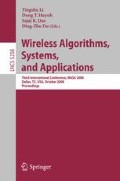Abstract
Due to the randomness and mobility of ad hoc networks, estimating the average number of hops becomes very essential in multi-hop ad hoc networks, which is used as a key metric for performance comparison between multi-hop routing protocols; however, most current research derives the average number of hops based on simulations and empirical results, lacking the theoretical analysis of this essential metric. This paper presents a theoretical study of the expected number of hops between any two random nodes using typical modeling assumptions -an N-node randomly Poisson distributed connected network (i.e. for any two random nodes, they are connected by at least one path). The proposed theoretical analysis studies the relationship between the average number of hop counts and other critical ad hoc network parameters such as transmission range (r 0), node density (ρ), and area (A). At last, simulation results will be given to verify the theoretical analysis.
Access this chapter
Tax calculation will be finalised at checkout
Purchases are for personal use only
Preview
Unable to display preview. Download preview PDF.
References
Perkins, C.E. (ed.): Ad hoc networking. Addison-Wesley, Reading (2000)
Li, J., Blake, C., Couto, D., Lee, H., Morris, R.: Capacity of ad hoc wireless networks. In: Proc. ACM MobiCom, pp. 61–69 (2001)
Jun, J., Sichitiu, M.: The nominal capacity of wireless mesh networks. IEEE Wireless Commun. 10(5), 8–14 (2003)
Gamal, A., Mammen, J., Prabhakar, B., Shah, D.: Throughput–delay trade-off in wireless networks. In: Proc. IEEE Infocom, pp. 464–475 (2004)
Cheng, Z., Heinzelman, W.B.: Flooding strategy for target discovery in wireless networks. In: Proc. ACM MSWiM, September 2003, pp. 33–41 (2003)
Kleinrock, L., Silvester, J.: Optimum transmission radii for packet radio networks or why six is a magic number. In: Proc. IEEE Nat. Telecommun. Conf., Birmingham, AL, December 1978, pp. 4.3.1–4.3.5 (1978)
Hou, T.C., Li, V.O.K.: Transmission range control in multi-hop packet radio networks. IEEE Trans. Commun. COM-34(1), 38–44 (1986)
Nagpal, R., Shrobe, H., Bachrach, J.: Organizing a global coordinate system from local information on an
Li, D.Y.: A statistical study of Neighbor Node properties in Ad hoc network. In: International Conference on Parallel Processing Workshops, pp. 103–108 (2002)
Cressie, N.A.C.: Statistics for Spatial Data. John Wiley & Sons, Chichester (1991)
Bettstetter, C.: On the Minimum Node Degree and Connectivity of a Wireless Multi-hop Network. In: Proceedings of the 3rd ACM international symposium on Mobile Ad hoc networking & computing, pp. 80–91 (2000)
Miller, L.E.: Distribution of Link Distances in a Wireless Network. NIST J. of Research (Spring 2001)
Dousse, O., et al.: Connectivity in ad hoc and hybrid networks. In: Proc. Infocom (2002)
Papoulis, Probability, random variables, and stochastic processes. McGraw–Hill, New York (1984)
The MathWorks: http://www.mathworks.com
Diestel, R.: Graph Theory, 2nd edn. Springer, Heidelberg (2000)
Bollob´as, B.: Modern Graph Theory. Springer, Heidelberg (1998)
Johnson, D.B., Maltx, D.A.: Dynamic Source Routing in Ad hoc Wireless Network. In: Tmielinski, T., Korth, H. (eds.) Mobile Computing, ch. 5, Kluwer Academic, Dordrecht (1996)
Johnson, D.B., Maltx, D.A.: The Dynamic Source Routing Protocol for Mobile Ad hoc Network (DSR) (April 2003)
Perkins, C.E., Royer, E.M.: Ad hoc On-Demand Distance Vector Routing. In: Proceeding of 2nd IEEE Workshop on Mobile Computing Systems and Applications, pp. 90–100 (February 1999)
Perkins, C.E., Royer, E.M.: Ad hoc On-Demand Distance Vector Routing (AODV) (July 2003), http://www.ietf.org/rfc/rfc3561.txt
Scalable Networks Technologies, http://www.scalable-networks.com/
Chang, N., Liu, M.: Revisiting the TTL-based controlled flooding search: Optimality and randomization. In: Proc. ACM MobiCom, September 2004, pp. 85–99 (2004)
Bruno, R., Conti, M., Gregori, E.: Mesh networks: Commodity multi-hop ad hoc networks. IEEE Commun. Mag. 43(3), 123–131 (2005)
Author information
Authors and Affiliations
Editor information
Editors and Affiliations
Rights and permissions
Copyright information
© 2008 Springer-Verlag Berlin Heidelberg
About this paper
Cite this paper
Harb, S.M., McNair, J. (2008). Analytical Study of the Expected Number of Hops in Wireless Ad Hoc Network. In: Li, Y., Huynh, D.T., Das, S.K., Du, DZ. (eds) Wireless Algorithms, Systems, and Applications. WASA 2008. Lecture Notes in Computer Science, vol 5258. Springer, Berlin, Heidelberg. https://doi.org/10.1007/978-3-540-88582-5_9
Download citation
DOI: https://doi.org/10.1007/978-3-540-88582-5_9
Publisher Name: Springer, Berlin, Heidelberg
Print ISBN: 978-3-540-88581-8
Online ISBN: 978-3-540-88582-5
eBook Packages: Computer ScienceComputer Science (R0)

